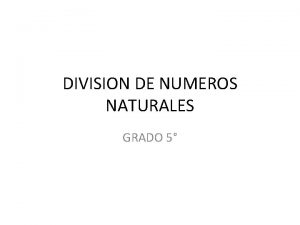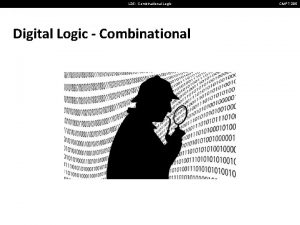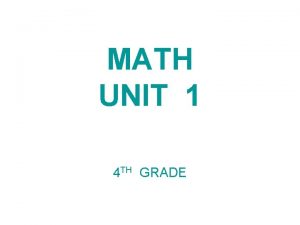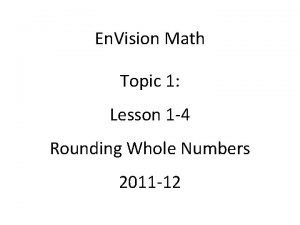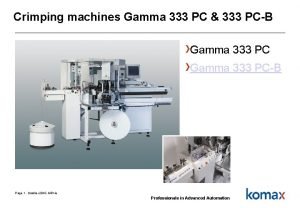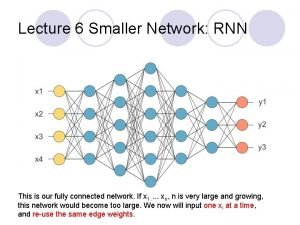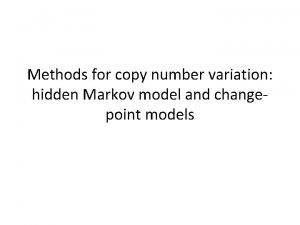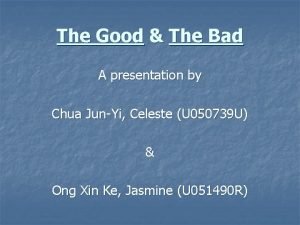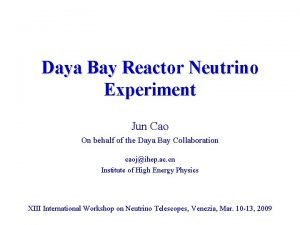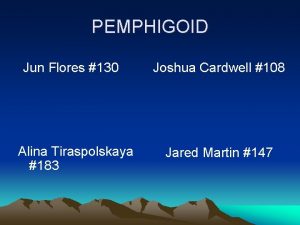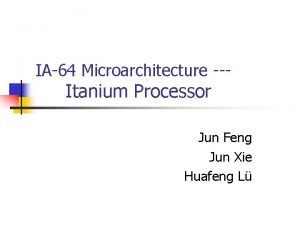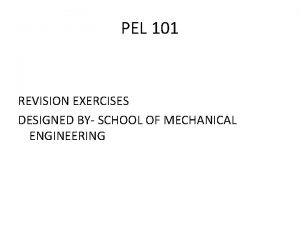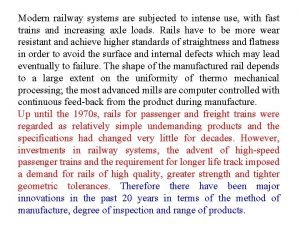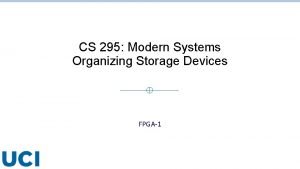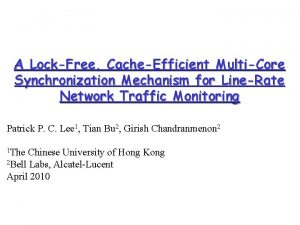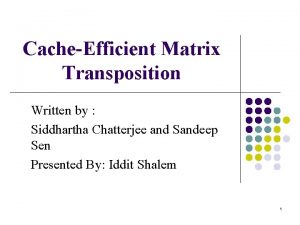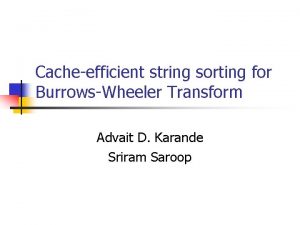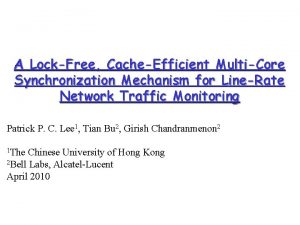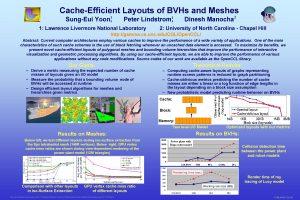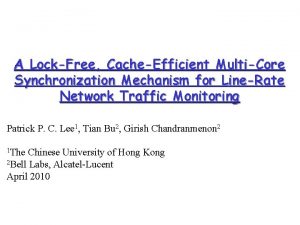CS 295 Modern Systems CacheEfficient Algorithms SangWoo Jun




























![Some Important Stencils [1] 19 -point 3 D Stencil for Lattice Boltzmann Method flow Some Important Stencils [1] 19 -point 3 D Stencil for Lattice Boltzmann Method flow](https://slidetodoc.com/presentation_image_h2/5a929b8227f110e3f316bf224a8168a5/image-29.jpg)





- Slides: 34

CS 295: Modern Systems Cache-Efficient Algorithms Sang-Woo Jun Spring, 2019

Back To The Matrix Multiplication Example q Blocked matrix multiplication recap o C 1 sub-matrix = A 1×B 11 + A 1×B 21 + A 1×B 31 … o Intuition: One full read of BT per S rows in A. Repeated N/S times A S N A 1 A 2 A 3 BT A 4 C B 11 B 12 B 13 B 14 × B 21 B 22 B 23 B 24 B 31 B 32 B 33 B 34 … C 1 = C 2 C 3 C 4

Back To The Matrix Multiplication Example q For sub-block size S × S -> N * (N/S) reads. What S do we use? o Optimized for L 1? (64 Ki. B for me, who knows for who else? ) o If S*S exceeds cache, we lose performance o If S*S is too small, we lose performance q Do we ignore the rest of the cache hierarchy? o Say S optimized for L 3, S × S multiplication is further divided into T×T blocks for L 2 cache o T × T multiplication is further divided into U×U blocks for L 1 cache o …

Solution: Cache Oblivious Algorithms q No explicit knowledge of cache architecture/structure o Except that one exists, and is hierarchical o Also, “tall cache assumption”, which is natural q Still (mostly) cache optimal q Typically divide-and-conquer algorithms B B/M Tall cache assumption: B 2 < c. M for a small c ex) Modern Intel L 1: M: 64 Ki. B, B: 16 B

Aside: Even More Important With Storage/Network q Latency difference becomes even larger o o Cache: ~5 ns DRAM: 100+ ns Network: 10, 000+ ns Storage: 100, 000+ ns q Access granularity also becomes larger o Cache/DRAM: Cache lines (64 B) o Storage: Pages (4 KB – 16 KB) Also see: “Latency Numbers Every Programmer Should Know” https: //people. eecs. berkeley. edu/~rcs/research/interactive_latency. html

Applications of Interest q q Matrix multiplication Merge Sort Stencil Computation Trees And Search

Recursive Matrix Multiplication C A C 11 C 12 C 21 C 22 = = B A 11 A 12 A 21 A 22 × A 11 B 11 A 11 B 12 A 21 B 11 A 21 B 12 B 11 B 12 B 21 B 22 + 8 multiply-adds of (n/2) × (n/2) matrices Recurse down until very small A 12 B 21 A 12 B 22 A 22 B 21 A 22 B 22

Performance Analysis q Also, log. N function call overhead is not high

Bonus: Cache-Oblivious Matrix Transpose q Also possible to define recursively AT A A 11 A 12 A 11 T A 21 A 22 A 12 T A 22 T

Applications of Interest q q Matrix multiplication Trees And Search Merge Sort Stencil Computation

Trees And Search q Binary Search Trees are cache-ineffective o e. g. , Searching for 72 results in 3 cache line reads o Not to mention trees in the heap! Cache blocks B 1 50 Tree layers L 1 20 L 2 70 10 30 L 3 60 90 B 4 B 3 B 2 1 11 25 33 55 66 72 99 L 4 Each traversal pretty much hits new cache line: Ɵ(Log(N)) cache lines read

Better Layout For Trees q Tree can be organized into locally encoded sub-trees o Much better cache characteristics! o We want cache-obliviousness: How to choose the size of sub-tree? Cache blocks B 1 50 Tree layers 20 L 1+L 2 70 … 1 11 (L 3+L 4)1 30 B 4 B 3 B 2 10 … 25 33 (L 3+L 4)2 60 55 66 (L 3+L 4)3 90 72 99 (L 3+L 4)4

van Emde Boas Layout q ceiling(h/4) ceiling(h/2) A ceiling(h/4) h ceiling(h/4) ceiling(h/2) ceiling(h/4) A… B 1 … … Bk Bk …

Performance Evaluations Against Binary Tree 1 GHz Pentium III (Coppermine) 256 KB cache 1 GB DRAM * Pointer: pointer to two children * Implicit: calculates children location Brodal et. al. , “Cache Oblivious Search Trees via Binary Trees of Small Height, ” SODA 02

Performance Evaluations Against Binary Tree And B-Tree * High 1024: 1024 elements per node, to make use of the whole cache line (B-Tree) Question: How do we optimize N in High. N? Databased use N optimized for storage page Brodal et. al. , “Cache Oblivious Search Trees via Binary Trees of Small Height, ” SODA 02

More on the van Emde Boas Tree q Actually a tricky data structure to do inserts/deletions o Tree needs to be balanced to be effective o van Emde Boas trees with van Emde Boas trees as leaves? q Good thing to have, in the back of your head!

Applications of Interest q q Matrix multiplication Trees And Search Merge Sort Stencil Computation

Merge Sort Depth-first Source: https: //imgur. com/gallery/vout. F, created by morolin Breadth-first

Merge Sort Cache Effects q R

k 3 Lazy K-Merger q k 3/2 … … k

Lazy K-Merger Procedure Fill(v): while v’s output buffer is not full if left input buffer empty Fill(left child of v) if right input buffer empty Fill(right child of v) perform one merge step q Each k merger fits in k 2 space q Ideal cache effects! o Proof too complex to show today… q What should k be? o Given N elements, k = N(1/3) – “Funnelsort”

Source: Brodal et. al. , “Engineering a Cache-Oblivious Sorting Algorithm” In-Memory Funnelsort Empirical Performance Overhead… Probably need SIMD to really test memory limitations

Source: Brodal et. al. , “Engineering a Cache-Oblivious Sorting Algorithm” In-Memory Funnelsort Empirical Performance Improvement! Overhead… Athlon has more L 1, Less L 2. Is that why?

Source: Brodal et. al. , “Engineering a Cache-Oblivious Sorting Algorithm” In-Storage Funnelsort Empirical Performance Improvement! Storage-optimized Library!

Applications of Interest q q Matrix multiplication Trees And Search Merge Sort Stencil Computation

Stencil Computation q Example: Heat diffusion o Uses parabolic partial differential equation to simulate heat diffusion

Heat Equation In Stencil Form q Simplified model: 1 -dimensional heat diffusion

A 3 -point Stencil q u(x, t + Δt) can be calculated using u(x, t), u(x + Δx, t), u(x - Δx, t) q A “stencil” updates each position t using surrounding values as input o This is a 1 D 3 -point stencil o 2 D 5 point, 2 D 9 point, 3 D 7 point, 3 D 25 -point stencils popular o Popular for simulations, including fluid dynamics, solving linear equations and PDEs Sentries x
![Some Important Stencils 1 19 point 3 D Stencil for Lattice Boltzmann Method flow Some Important Stencils [1] 19 -point 3 D Stencil for Lattice Boltzmann Method flow](https://slidetodoc.com/presentation_image_h2/5a929b8227f110e3f316bf224a8168a5/image-29.jpg)
Some Important Stencils [1] 19 -point 3 D Stencil for Lattice Boltzmann Method flow simulation [1] Peng, et. al. , “High-Order Stencil Computations on Multicore Clusters” [2] Gentryx, Wikipedia [2] 25 -point 3 D stencil for seismic wave propagation applications

Cache Behavior of Naïve Loops q Using the 1 D 3 -point stencil o Unless x is small enough, there is no cache reuse q Continuing theme, can we recursively process data in a cacheoptimal way? t x

Cache Efficient Processing: Trapezoid Units q Computation in a trapezoid is either: o Self-contained, does not require anything from outside( ), or o Only uses data that has been computed and ready ( , after ) t x

Recursion #1: Space Cut q If width >= height × 2 o Cut the trapezoid through the center using a line of slope -1 o Process left, then right t x

Recursion #2: Time Cut q If width < height × 2 o Cut the trapezoid with a horizontal line through the center o Process bottom, then top t x

Analysis q Intuitively, trapezoids are split until they are of size M (cache size) q Data read = Ɵ(NT/M) o Cache lines read = Ɵ(NT/MB) q Let’s look at a performance video!
 Divisiones quinto grado
Divisiones quinto grado Pages 294 and 295
Pages 294 and 295 Cmpt 295
Cmpt 295 Decreto 295
Decreto 295 Round 493 295 to the nearest ten thousand
Round 493 295 to the nearest ten thousand 160 656 rounded to the nearest hundred thousand
160 656 rounded to the nearest hundred thousand Komax bc
Komax bc Kj no 295
Kj no 295 Jun akizaki
Jun akizaki 05 jun 2015 networks say
05 jun 2015 networks say Jun feb mar
Jun feb mar Pptmoban
Pptmoban Jun s. liu
Jun s. liu Jun xu md
Jun xu md Jun akizaki
Jun akizaki 55+46
55+46 Chua jun yi
Chua jun yi Xxxxxxx27
Xxxxxxx27 Brainybetty
Brainybetty Jun cao
Jun cao Daniel jun
Daniel jun Jun flores
Jun flores Umjetnost druge polovice 20. stoljeća
Umjetnost druge polovice 20. stoljeća Xie jun feng
Xie jun feng Gimnasio jun
Gimnasio jun School revision 101
School revision 101 Rel8 group
Rel8 group Modern systems analysis and design
Modern systems analysis and design Modern railway systems
Modern railway systems Modern operating systems
Modern operating systems History of morphine
History of morphine Virtualization technology in modern operating systems
Virtualization technology in modern operating systems Modern systems analysis and design
Modern systems analysis and design A modern approach to systems analysis and design
A modern approach to systems analysis and design Modern operating systems 3rd edition
Modern operating systems 3rd edition
